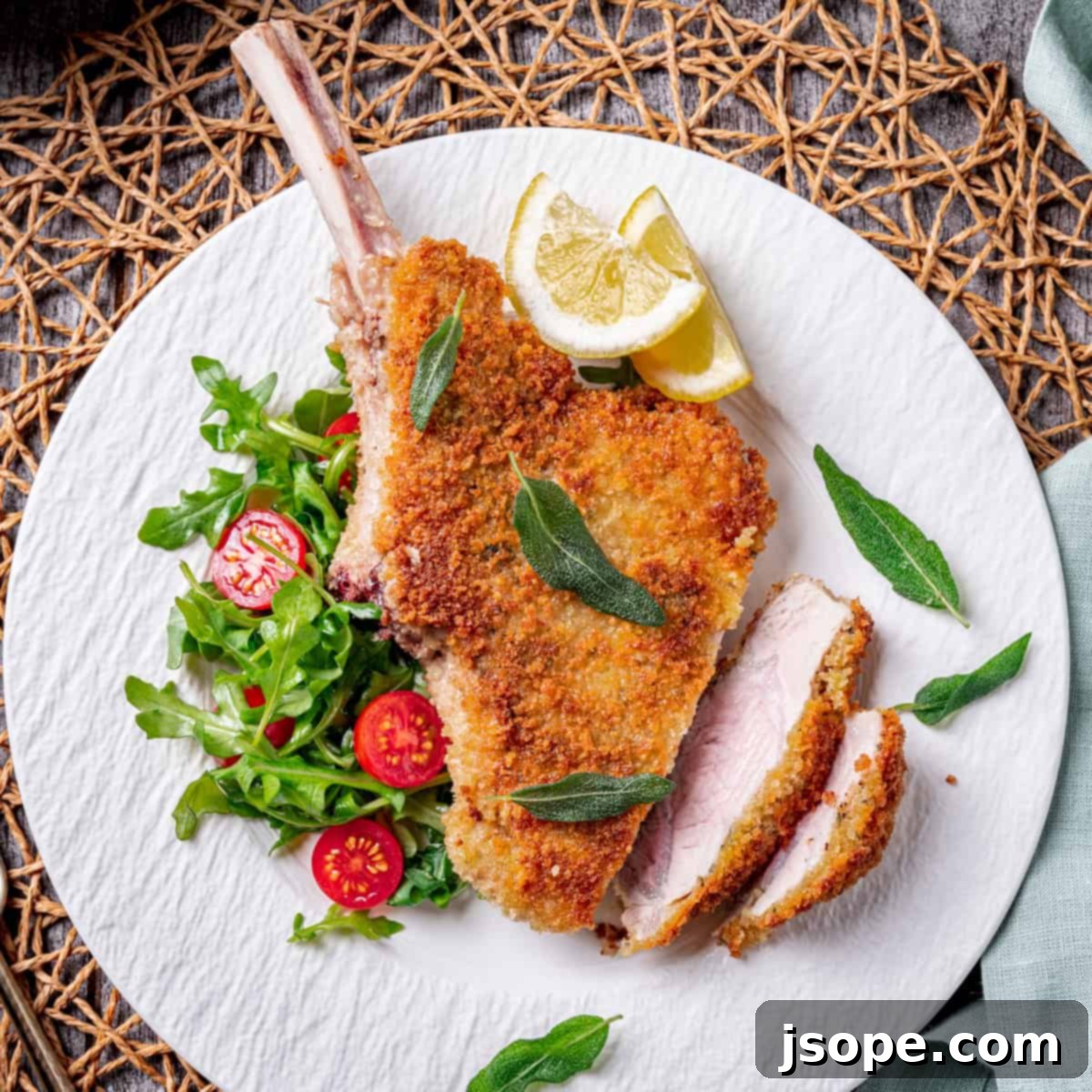Indulge in a true Italian classic that effortlessly blends simplicity with extraordinary flavor: Bone-In Veal Milanese (Cotoletta alla Milanese). This iconic dish, a staple in Milanese culinary tradition, is surprisingly straightforward to prepare yet delivers an incredibly satisfying gourmet experience. Having savored this delicacy countless times in its birthplace, Milan, and replicated it with passion in our own kitchen, we’re thrilled to share our perfected recipe. Our version incorporates subtle enhancements to the classic preparation, elevating it to an even more delicious level. It’s an ideal choice for a memorable date night, a special occasion, or simply when you crave a taste of authentic Italy, promising a quick and easy journey to culinary delight.
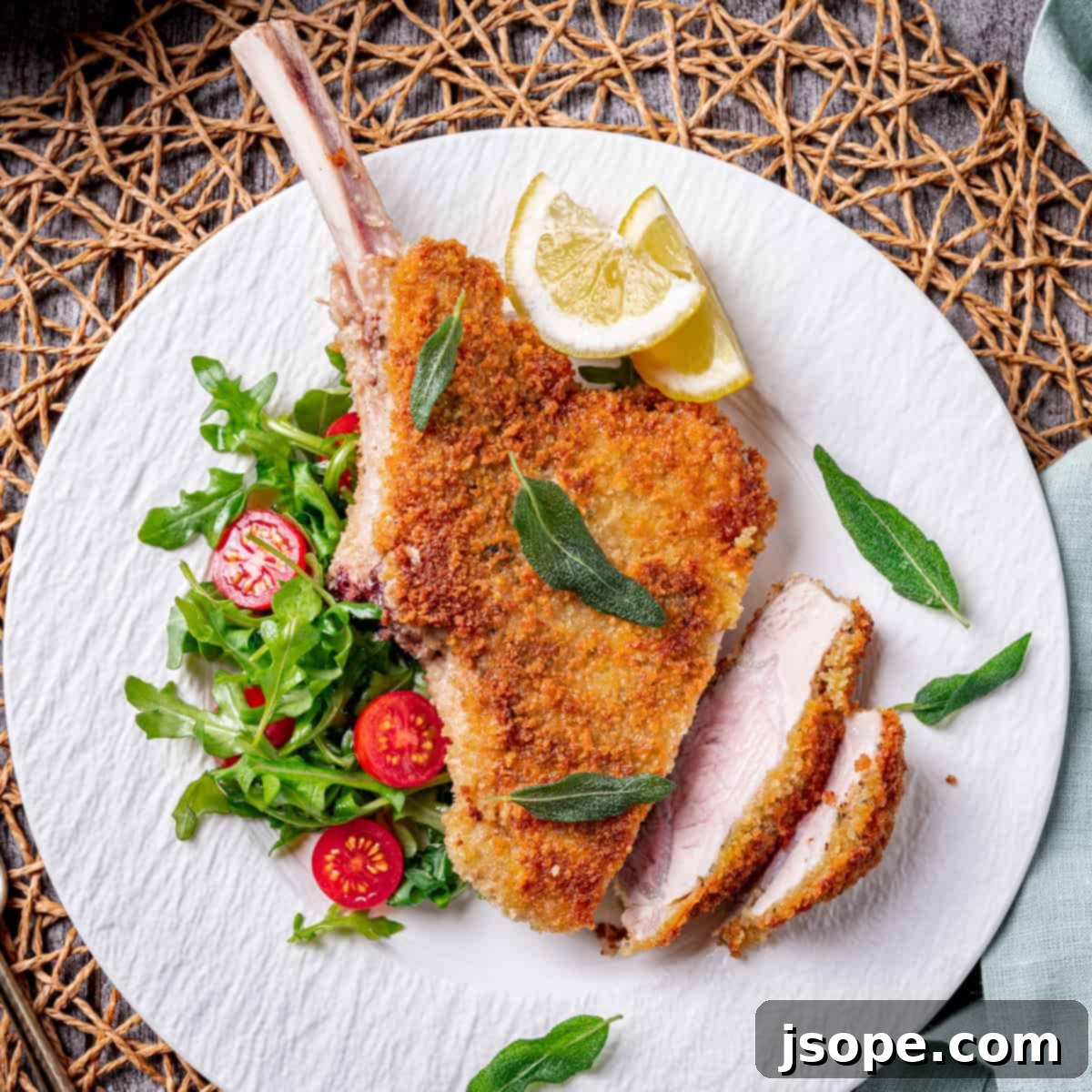
Craving more authentic Italian flavors? Explore our selection of beloved recipes. Delight your palate with our Creamy Cacio e Pepe Pasta, a Roman pasta masterpiece, savor the aromatic Saltimbocca alla Romana, or enjoy a modern twist on a classic with our Spaghetti Carbonara with Asparagus.
Jump to: What is Veal Milanese | Veal vs Beef | Why You’ll Love This Recipe | Ingredients | Substitutions | How to Make | Equipment | Step-by-Step Instructions | Variations | Storage | Top Tip | Troubleshooting | What to Serve With | Wine Pairings | FAQ | Recipe Card | Food Safety
What is Veal Milanese (Cotoletta alla Milanese)?
Veal Milanese, known in Italy as Cotoletta alla Milanese, is far more than just a breaded chop; it’s a testament to the elegant simplicity of Northern Italian cuisine. Originating from Milan, the capital of Lombardy, this dish embodies a culinary philosophy where a few high-quality ingredients are transformed into something truly spectacular through precise technique. While it shares conceptual similarities with other breaded cutlets found across Europe, such as Austrian Schnitzel, the Milanese version holds its distinct identity, primarily through its use of bone-in veal and its preparation method.
At its heart, Veal Milanese involves a tender, bone-in veal chop, gently pounded to an even thickness (often matching the bone), seasoned, coated in a delicate layer of breadcrumbs, and then pan-fried in clarified butter until golden brown and irresistibly crispy. The magic lies in this delicate frying, which creates a crust that shatters with every bite, revealing juicy, tender veal beneath. Unlike many other breaded cutlets, the traditional Milanese preparation typically omits flour, relying solely on egg and breadcrumbs for the coating, which results in a lighter, purer texture that allows the veal’s subtle flavor to shine.
Despite its impressive presentation and reputation, the beauty of Cotoletta alla Milanese lies in its straightforward execution. Don’t be fooled by its simplicity; a perfectly made Veal Milanese is anything but boring or bland. The combination of succulent, mild veal, fresh aromatic herbs, and a rich, buttery, golden-brown crust creates an unforgettable flavor profile that has captivated diners for centuries.
Veal vs. Beef: Understanding the Difference
While both veal and beef come from cattle, they offer distinctly different culinary experiences due to the age, breed, and upbringing of the animals. Veal is specifically sourced from young cattle, typically calves under one year old, often male calves from dairy farms that aren’t needed for milk production. Beef, on the other hand, comes from mature cattle raised specifically for meat.
This age difference results in significant variations in flavor, texture, and color. Veal is notably lighter in color, often resembling pork, and possesses a much finer grain and more delicate texture than beef. Its flavor is milder and sweeter, lacking the robust, more intense “beefy” notes found in older cattle. This subtle flavor profile makes veal incredibly versatile and highly prized in many European cuisines, particularly Italian. Chefs often compare veal’s tenderness and mildness to that of chicken or pork, yet it boasts a unique depth of flavor that stands on its own.
Although similar breaded cutlets can be made with pork, chicken, or even beef, it’s crucial to understand that an authentic Cotoletta alla Milanese, by definition, is always prepared with veal. The unique characteristics of veal are fundamental to achieving the traditional taste and texture that define this classic Milanese dish.
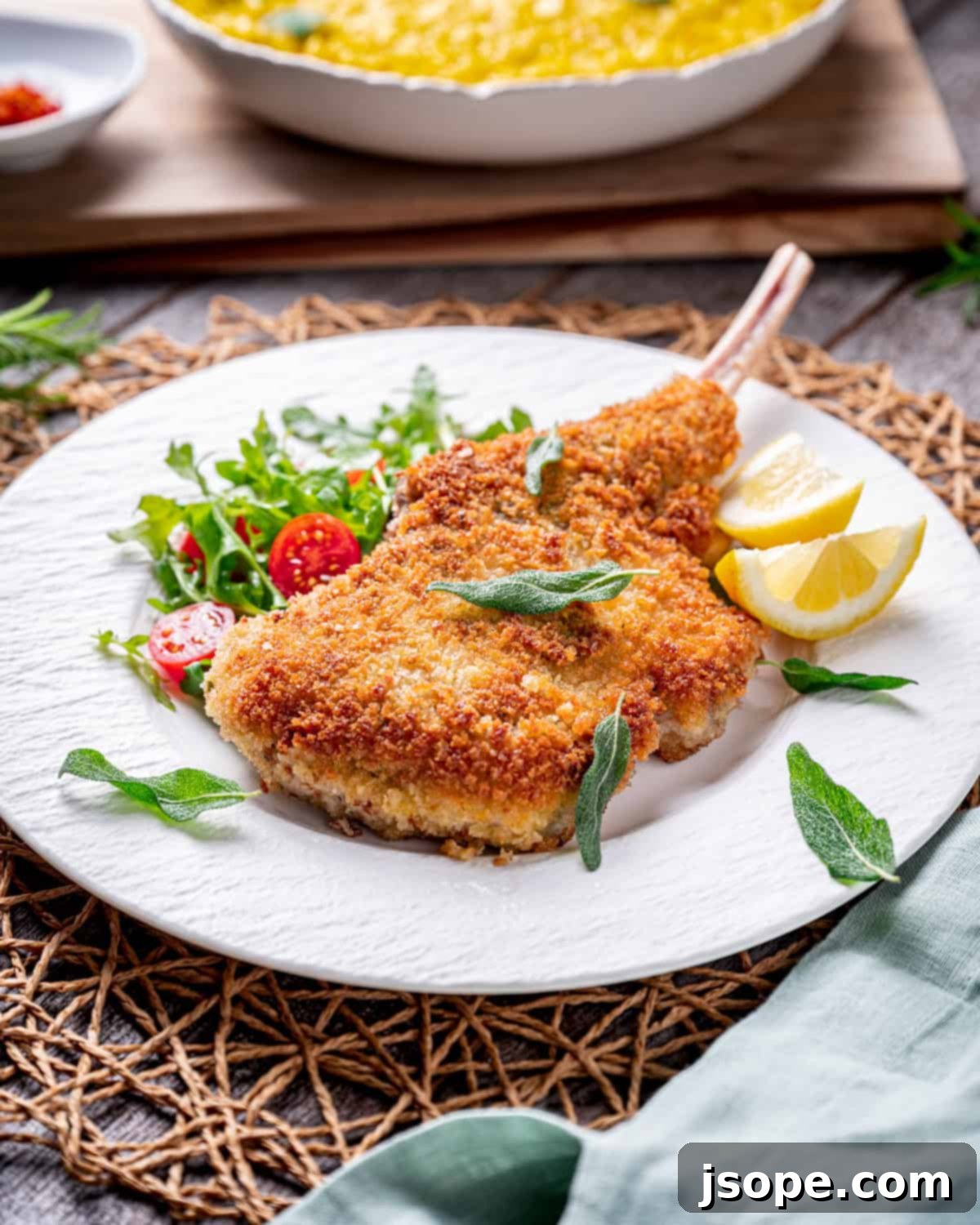
Why You’ll Love This Bone-In Veal Milanese Recipe
This Bone-In Veal Milanese recipe isn’t just a meal; it’s an experience waiting to happen. Here’s why you’ll fall in love with it:
- Quick and Easy Preparation: Despite its gourmet appearance, this dish is surprisingly simple and fast to make. With just a few key steps, you can have a restaurant-quality meal on your table in under an hour, making it perfect even for weeknights.
- Impressive & Elegant: Don’t let the ease fool you; a perfectly cooked Veal Milanese is a showstopper. Its golden crust and tender interior make it an incredibly impressive dish to serve guests or for a special family dinner.
- Ideal for Date Night or Special Occasions: The combination of its sophisticated flavor and straightforward preparation makes it a go-to for romantic dinners or celebrations where you want to impress without spending hours in the kitchen.
- Unforgettable Flavor Profile: The delicate, sweet taste of high-quality veal is perfectly complemented by the savory, buttery, and herb-infused crispy crust. Every bite is a harmonious blend of textures and aromas that truly sings of Italian tradition.
- Tender, Juicy Veal with a Crispy Crust: We’ve refined the technique to ensure the veal remains incredibly tender and juicy on the inside, while the exterior boasts an irresistible, perfectly golden, and satisfyingly crispy breading. This contrast is what makes Veal Milanese so special.
Essential Ingredients for Bone-In Veal Milanese
Crafting the perfect Bone-In Veal Milanese begins with selecting the finest ingredients. Here’s a detailed look at what you’ll need and why each component is crucial:
- Bone-In Veal Chops: The star of the show. For an authentic Cotoletta alla Milanese, bone-in veal chops are essential. They impart a richer flavor and help keep the meat moist during cooking. Look for chops that are about 1 to 1.5 inches thick. While they can sometimes be a challenge to find at standard grocery stores, your local butcher is often the best source, or you can order them online for convenience here.
- Kosher Salt: Essential for seasoning the veal generously. Kosher salt provides a clean, briny flavor and its coarse texture adheres well to the meat.
- Black Pepper: Freshly ground black pepper adds a pungent, aromatic warmth that complements the veal beautifully.
- Fresh Rosemary Sprigs: Finely chopped fresh rosemary introduces a fragrant, piney, and slightly citrusy note that pairs exceptionally well with the subtle sweetness of veal. It’s one of our secret twists that elevates the classic.
- Fresh Sage Leaves: Finely chopped fresh sage offers an earthy, slightly peppery, and robust flavor that creates a deep, aromatic layer alongside the rosemary.
- Egg: Acts as the binding agent, creating a crucial bridge for the breadcrumbs to adhere firmly to the veal. A well-beaten egg wash ensures an even and robust coating.
- Breadcrumbs: While traditional recipes often use fine breadcrumbs, we highly recommend panko breadcrumbs for their superior texture. Panko creates an exceptionally light, airy, and extra-crispy crust, which is paramount for the perfect Milanese.
- Clarified Butter (Ghee): This is the fat of choice for frying. Clarified butter, or ghee, has a significantly higher smoke point than regular butter, meaning it can reach the necessary high temperatures for frying without burning. It also imparts a pure, rich buttery flavor that is fundamental to the dish.
- Lemon: Fresh lemon wedges are served alongside the cooked veal. A squeeze of fresh lemon juice just before eating brightens the rich flavors, adding a necessary acidic counterpoint.
- Fresh Parsley: Finely chopped fresh parsley is used for garnish, providing a touch of vibrant color and a fresh, herbaceous aroma.
Substitutions & Adaptations
While the classic Bone-In Veal Milanese calls for specific ingredients, here are some practical substitutions and adaptations to suit your needs or preferences:
- Fresh Herbs: The rosemary and sage combination is a fantastic addition, but if you prefer, you can omit one or both for a more minimalist flavor profile. Fresh thyme is another excellent herb that complements veal and can be used with good results if you’re looking for an alternative.
- Breadcrumbs: Our recipe champions panko for its superior crunch, but feel free to use your favorite type of breadcrumbs. Store-bought fine breadcrumbs or even homemade breadcrumbs will work. For a gluten-free option, easily substitute with gluten-free panko or other gluten-free breadcrumbs to make this dish accessible to everyone.
- Clarified Butter: If clarified butter or ghee is unavailable, unsalted butter can be used. However, be mindful that the milk solids in unsalted butter will brown and potentially burn at lower temperatures, which might lead to a darker crust or slightly burnt bits in the pan. To mitigate this, consider adding a splash of olive oil to the pan along with the butter; the olive oil helps raise the overall smoke point.
- Veal Chops: High-quality veal can sometimes be difficult to source or may not fit every budget. For a delicious and accessible alternative, bone-in pork chops are an excellent substitute. You may need to pound them a bit more vigorously to achieve optimal tenderness. Other boneless protein options include thin veal cutlets or scallopini, boneless pork chops, or even chicken cutlets, all of which can be prepared using the same method for a quick and satisfying meal.
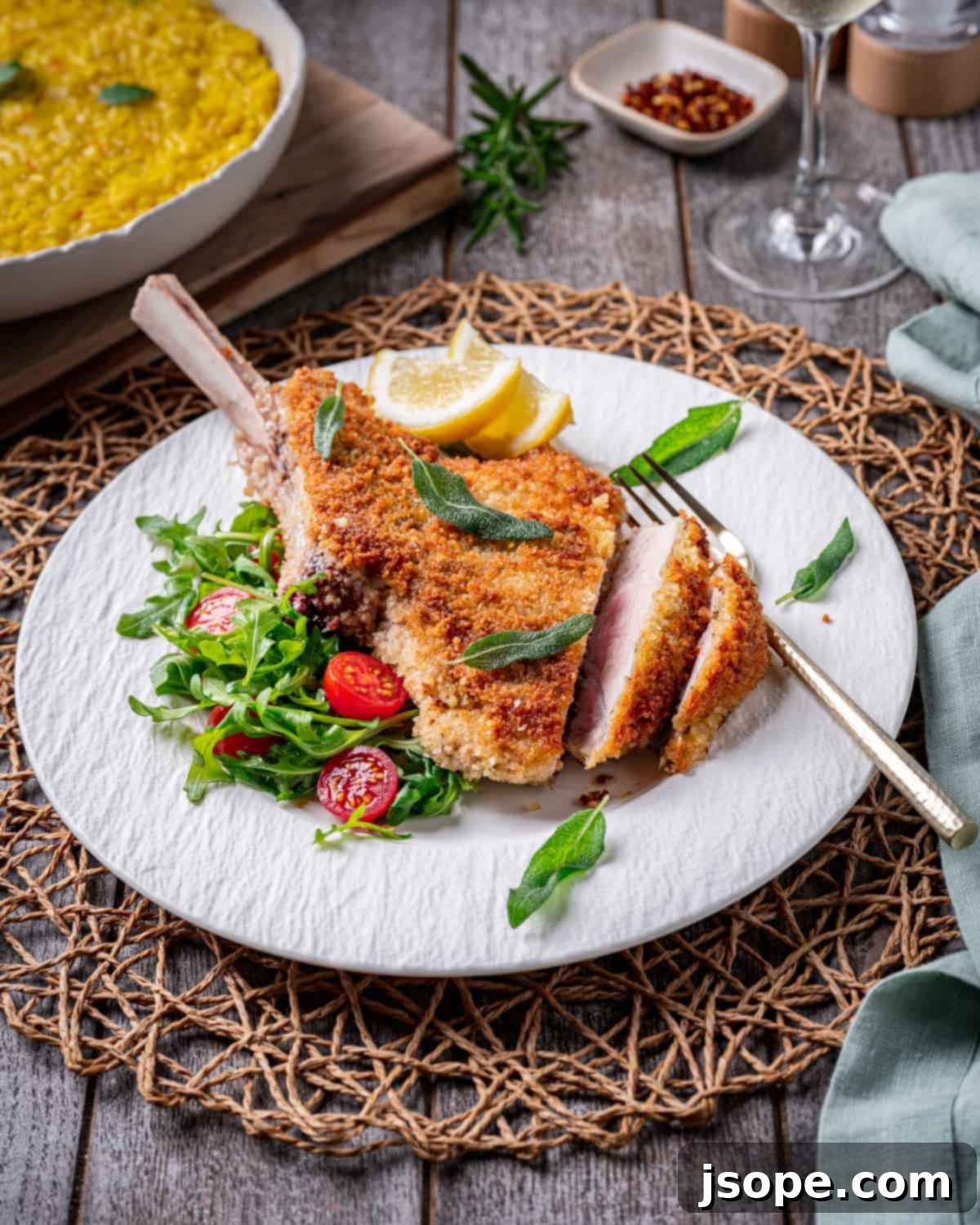
How to Make Bone-In Veal Milanese: A Simple Guide
Creating this exquisite Bone-In Veal Milanese is a surprisingly easy and rewarding culinary adventure. The process is straightforward, focusing on careful preparation and precise cooking to achieve that perfect balance of tender veal and a golden, crispy crust. It all starts with preparing your veal chops to the ideal thickness, seasoning them thoughtfully, then coating them expertly in egg and breadcrumbs. Finally, a gentle pan-fry in clarified butter brings it all together. The result is a dish that’s ready to be served simply with a bright squeeze of fresh lemon and a sprinkle of chopped parsley, transforming humble ingredients into a truly memorable meal.
Essential Equipment for Your Milanese
Having the right tools makes preparing Bone-In Veal Milanese even smoother. Here’s what you’ll need:
- Meat Mallet: Crucial for gently pounding the veal chops to an even thickness, ensuring uniform cooking and tenderness.
- Large Nonstick Skillet or Frying Pan: A spacious pan is essential for frying the veal evenly without overcrowding, which helps achieve that perfect golden crust.
- Baking Pans, Shallow Bowls, or Sheet Trays: You’ll need three separate, shallow containers to organize your breading station (one for seasoned veal, one for egg wash, and one for breadcrumbs) for a clean and efficient coating process.
- Instant Read Meat Thermometer: Your best friend for ensuring the veal is cooked to a perfect medium-rare (142°F / 61°C) without overcooking, guaranteeing maximum tenderness and juiciness.
Step-by-Step Instructions for Bone-In Veal Milanese
Follow these detailed steps to create a truly exceptional Bone-In Veal Milanese:
1. Pound and Season the Veal Chops
- Place each bone-in veal chop between two sheets of plastic wrap or in a large zip-top bag. Using a meat mallet, gently but firmly pound the veal chops. Aim for an even thickness throughout the meat. We typically prefer ours to be about ⅔ to ¾ of an inch thick, or slightly thicker than the bone, to retain some chew and juiciness. Avoid pounding too thin, as this can make the meat tough and dry. Once pounded, remove the plastic wrap and place the veal on a baking rack set over a sheet pan. Season both sides generously with kosher salt, black pepper, finely chopped fresh rosemary, and fresh sage. The rack allows for air circulation. Transfer the seasoned veal to the refrigerator and let it rest for at least 15-20 minutes while you prepare the breading station. This brief chill helps the seasoning penetrate and ensures the meat is firm for breading.
2. Bread the Chops Perfectly
- Set up your breading station. Pour the panko breadcrumbs into a shallow baking pan or a large sheet tray. In a separate shallow bowl or sheet tray, crack the eggs and add a tablespoon of water. Whisk the eggs thoroughly with a fork until they are fully combined and slightly frothy, resembling scrambled eggs. Retrieve the seasoned veal chops from the refrigerator. One at a time, dip each chop into the beaten egg mixture, ensuring all sides of the meaty portion are thoroughly coated. Allow any excess egg to drip off briefly before transferring the chop to the breadcrumbs. Press the breadcrumbs firmly into the veal with your hands, then sprinkle more breadcrumbs over the top and press them down again. Ensure the entire meaty surface (excluding the exposed bone) is completely and evenly coated. The goal is a thick, even layer of breading. Repeat this process for all remaining chops.
3. Cook the Veal to Golden Perfection
- In a large nonstick skillet or frying pan, heat the clarified butter over medium heat. Wait until the butter is shimmering but not smoking. Carefully transfer the breaded veal chops into the hot pan, taking care not to overcrowd it. Cook the chops gently for approximately 4-5 minutes per side. The key here is careful temperature management: you may need to adjust the heat up or down slightly to ensure the crust develops a beautiful, rich golden-brown color without burning, while simultaneously allowing the veal to cook through to a perfect medium-rare (internal temperature of 142°F / 61°C). Use an instant-read meat thermometer to accurately check the internal temperature, inserting it into the thickest part of the meat, away from the bone. If the heat is too high, the breading will brown too quickly, leaving the interior raw. Conversely, too low heat will result in a soggy crust. Once cooked to perfection, transfer the Veal Milanese to a clean plate or cutting board.
4. Serve and Enjoy
- Serve your magnificent Bone-In Veal Milanese immediately. Garnish each chop with a fresh lemon wedge, allowing diners to squeeze a bright burst of citrus juice over the veal. If desired, a light sprinkle of finely chopped fresh parsley adds a final touch of color and freshness. Enjoy this exquisite Italian classic!
Creative Variations for Your Veal Milanese
While the classic Veal Milanese is perfect as is, these variations offer delightful ways to experiment with flavors and ingredients:
- Substitute with Bone-In Pork Chops: If high-quality veal is hard to find or if you’re looking for a more budget-friendly option, bone-in pork chops make an excellent substitute. Follow the recipe exactly, ensuring the pork chops are pounded to an even thickness to ensure tenderness and even cooking. The results are still incredibly flavorful and satisfying.
- Add Parmesan to the Breadcrumbs: For an extra layer of savory depth and a slightly cheesy, nutty crust, grate some fresh Parmesan cheese into your breadcrumbs. Approximately ¼ to ½ cup of finely grated Parmesan per cup of breadcrumbs will create a delicious “Parmesan crust” that complements the veal beautifully.
- Serve with a Complementary Sauce: Although traditional Veal Milanese is often served simply with a squeeze of lemon, adding a light sauce can enhance the experience. A delicate lemon beurre blanc or a light mushroom sauce can add a touch of richness and complexity without overpowering the delicate flavor of the veal.
Storage & Reheating Best Practices
Proper storage and reheating can help preserve the deliciousness of your Veal Milanese, though it’s best enjoyed fresh!
- Storing Leftovers: It’s rare to have leftovers of this incredibly delicious dish! However, if you do find yourself with a spare chop, ensure it cools completely to room temperature (within 2 hours of cooking). Then, transfer the leftover Veal Milanese to an airtight container and store it in the refrigerator for up to 3 days.
How to Reheat Leftover Veal Milanese?
- Reheating breaded cutlets can be tricky, as the goal is to warm the meat through without overcooking it further or making the crust soggy. The best method to preserve some crispiness is to reheat it in the oven. Place the veal chop on a wire rack set over a baking sheet (this allows air circulation for a crisper crust) and warm in a preheated oven at 325°F (160°C) until heated through, typically about 10-15 minutes, depending on thickness. Be aware that the internal temperature will rise, making the veal more well-done than its initial medium-rare. Reheating in a pan with a small amount of additional butter on low heat is also an option, but it requires careful attention to avoid burning the crust before the interior is warmed.
Can You Freeze Veal Milanese?
- We generally do not recommend freezing cooked Veal Milanese. The delicate crispy crust and tender texture are highly compromised during the freezing and thawing process, resulting in a less-than-ideal eating experience. It’s truly a dish best enjoyed freshly prepared.
Top Tip for Perfect Veal Milanese
For an authentic and superior Veal Milanese, remember that the classic dish traditionally does not use flour as an initial coating before the egg. We adhere to this tradition because it results in a lighter, crispier breading that doesn’t mask the delicate flavor of the veal. This means the egg and breadcrumbs are applied directly to the seasoned veal. The key to success is to be gentle! Handle the breaded veal chops with care during the coating and cooking process to ensure the precious crust remains intact and cooks to perfection without breaking or falling off.
Troubleshooting Common Veal Milanese Issues
One of the most frequent challenges when preparing Bone-In Veal Milanese is managing the cooking temperature. Achieving that perfect balance – a beautifully golden-brown, crispy crust with a tender, medium-rare veal interior – requires vigilance and adjustment.
If your heat is too high, you’ll quickly achieve a perfectly browned crust, but the veal inside will likely remain raw or severely undercooked. Conversely, if the heat is too low, the breading will absorb too much oil, resulting in a greasy, soggy crust rather than a crisp one, and the meat may take too long to cook through, potentially drying out. The ideal scenario is a consistently golden crust that forms as the veal cooks gently to its desired internal temperature.
To avoid these pitfalls, be prepared to manipulate the temperature of your stove throughout the cooking process. Start with medium heat to get the pan hot, then reduce it slightly to medium-low if the crust is browning too rapidly, or increase it a touch if it’s developing too slowly. Use an instant-read thermometer regularly to monitor the veal’s internal temperature and remove it from the pan promptly when it reaches 142°F (61°C) for medium-rare. Patience and attentiveness to the cooking temperature are crucial for achieving a flawless Bone-In Veal Milanese.
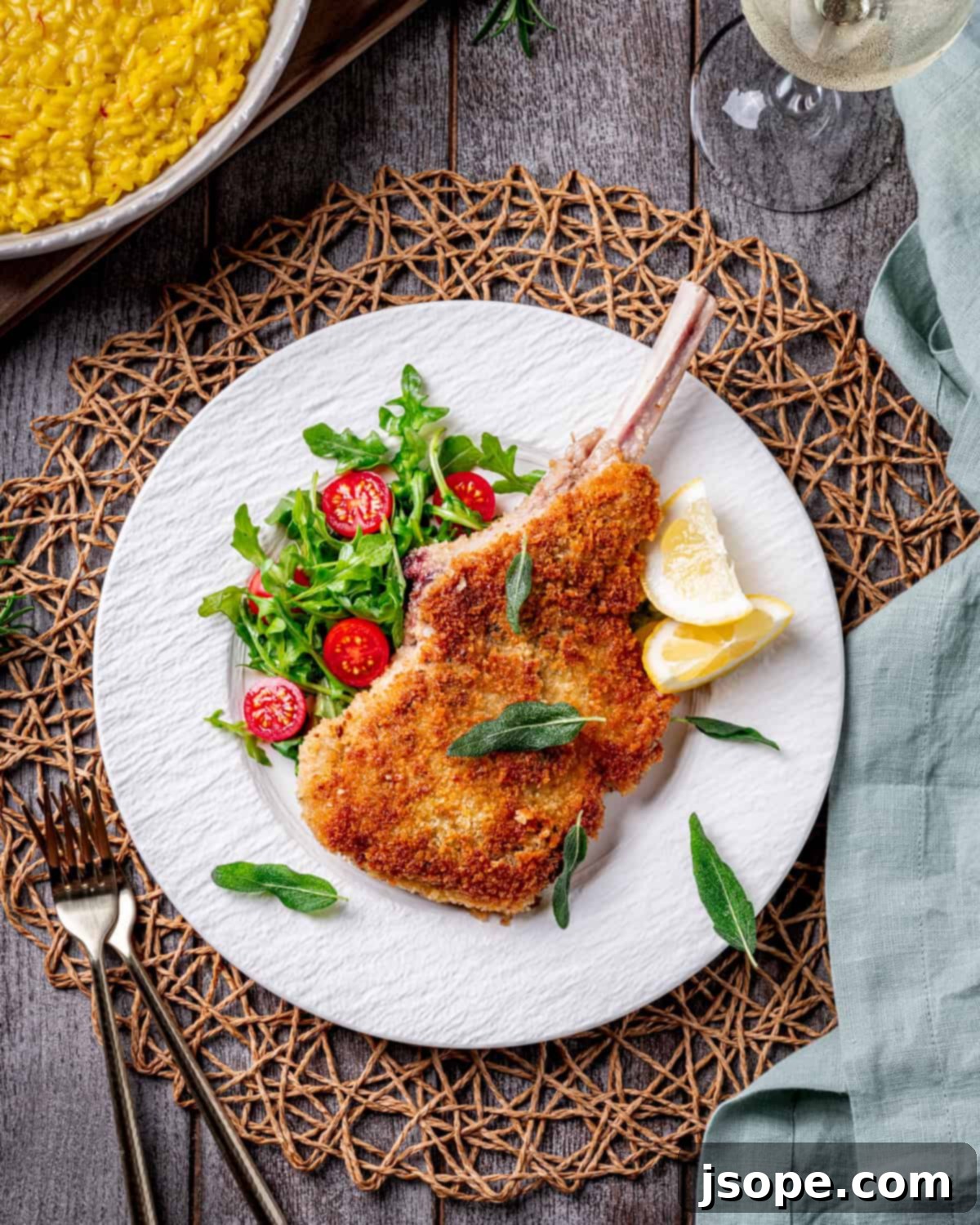
What to Serve with Bone-In Veal Milanese
The beauty of Bone-In Veal Milanese lies in its versatility with side dishes. For an authentic and classic pairing, emulate the Milanese tradition by serving it alongside a vibrant arugula salad. A simple dressing of fresh cherry tomatoes, a generous drizzle of good quality olive oil, and a squirt of lemon juice provides a delightful contrast of sweetness, bitterness, and acidity that perfectly cuts through the richness of the veal chop. This is precisely how we’ve enjoyed Cotoletta alla Milanese in Milan, and how it’s pictured in this very post.
If you desire something more substantial, Veal Milanese is an exceptional match for a creamy risotto. A classic Milanese Risotto, infused with saffron, would be a particularly harmonious choice, reflecting its regional origins.
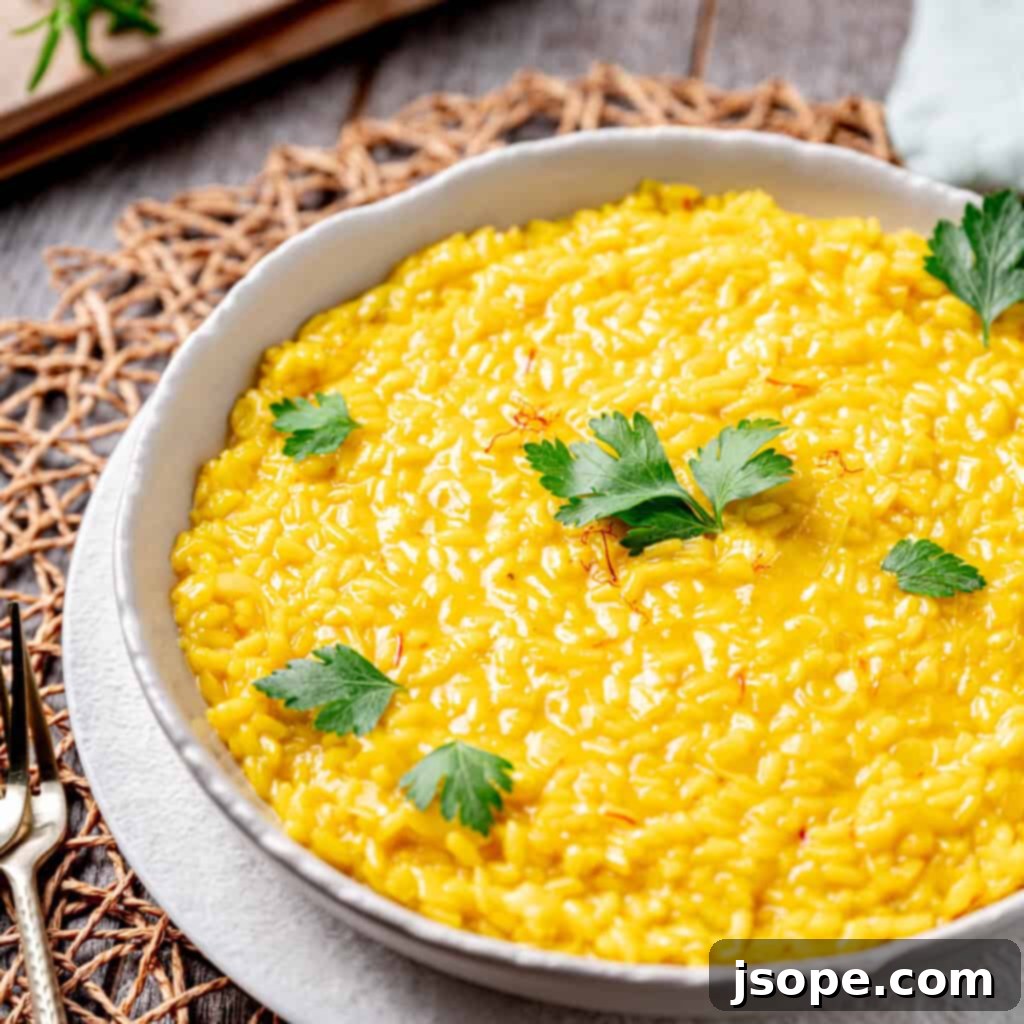
Perfect pairing!
Milanese-Style Creamy Saffron Leek Risotto
Elevate your meal with this ultimate creamy risotto, beautifully infused with saffron for its characteristic bright golden color and nuanced flavor.
Get the recipe →
Other excellent side dish options include a comforting potato dish like creamy mashed potatoes, or a rich polenta dish. Complement the meal with vibrant green vegetables such as sautéed broccolini, sweet peas, wilted spinach, or crisp green beans to complete your Italian feast.
What Wines Pair Best with Veal Milanese
Choosing the right wine can truly elevate your Veal Milanese experience. The delicate flavor of veal, coupled with the rich, buttery crust, allows for several excellent pairings. We have a couple of favorite recommendations, both white and red, to complement this exquisite dish.
For white wine enthusiasts, an Italian Chardonnay is a superb choice. Its crisp acidity and often subtle notes of apple or pear beautifully cut through the richness of the butter and complement the veal’s mildness. Alternatively, a dry Riesling, with its bright acidity and mineral undertones, also pairs wonderfully, offering a refreshing counterpoint to the dish.
If you prefer red wine, an Italian Primitivo (known as Zinfandel in the U.S.) is our top pick. Its jammy fruit flavors, notes of spice, and moderate tannins provide a lovely contrast and depth without overwhelming the veal. If a good Italian Primitivo is hard to come by, a high-quality California Zinfandel, especially one from regions like Dry Creek Valley known for their balanced Zins, will be an equally delightful option, bringing a robust yet smooth character to your meal.
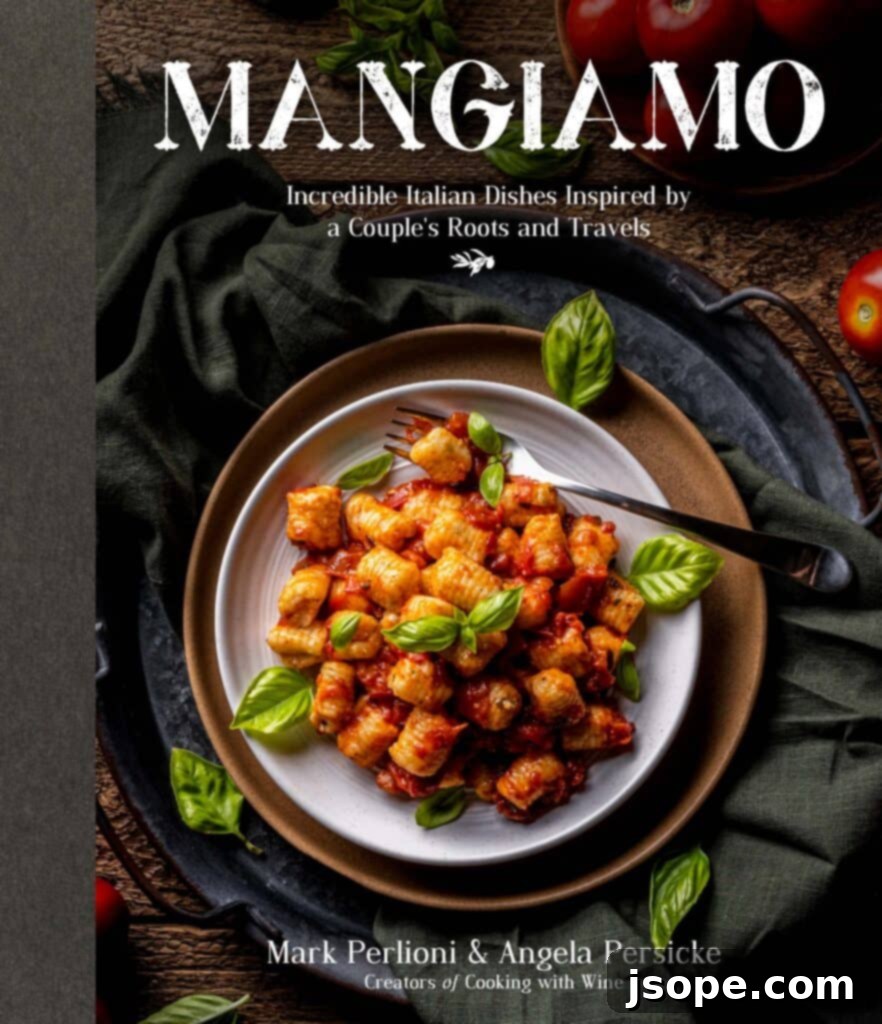
Mangiamo Cookbook
Deepen your culinary journey with our exclusive cookbook, Mangiamo. Featuring 60 exquisite Italian recipes, complete with mouth-watering images, it’s a heartfelt tribute to our Italian heritage and extensive culinary travels.
Frequently Asked Questions About Veal Milanese
What does Milanese mean in cooking?
In culinary terms, “Milanese” simply refers to a dish that originates from Milan, Italy, or is prepared in a style characteristic of traditional Milanese cuisine. This often implies a method involving breading and pan-frying, particularly with veal or chicken cutlets.
What’s the difference between Wiener Schnitzel and Veal Milanese?
While both are breaded and fried veal cutlets, the key differences lie in their preparation and cut of meat. Austrian Wiener Schnitzel is traditionally made with a very thin, boneless veal cutlet (often from the leg), pounded even thinner and typically fried in lard or butter. Veal Milanese, or Cotoletta alla Milanese, is classically prepared with a bone-in veal chop, pounded to a slightly thicker consistency, and pan-fried in clarified butter.
What’s the difference between Milanese and escalope?
An escalope is a general culinary term referring to a thin, boneless slice of meat (often veal, pork, or chicken) that has been pounded thinly. It can be prepared in various ways, including breaded and fried. Veal Milanese, on the other hand, is a specific type of escalope, characterized by being a bone-in veal chop that is pounded, breaded, and pan-fried in butter, adhering to a particular Milanese tradition.
What meat is closest to veal?
While some might suggest chicken or turkey for their adaptability in certain veal recipes (like piccata), these proteins don’t truly replicate the unique flavor and texture of veal. For the closest substitute in terms of delicate flavor and tenderness, a very high-quality, young pork offers the most similar characteristics. It needs to be carefully selected for its quality and tenderness to mimic veal effectively. Therefore, we generally recommend pork as the best substitute if veal is not available.
More Italian-Inspired Recipes to Explore
If you loved this recipe for Bone-In Veal Milanese, you’ll surely enjoy these other Italian-inspired dishes from our collection:
- Homemade Butternut Squash Ravioli Recipe
- Italian Herb Sautéed Zucchini Squash Recipe
- Garlic Herb Sautéed Italian Eggplant Recipe
- Pan Fried Risotto Cakes – Easy Leftover Risotto Recipe
Perfect Pairings to Complete Your Meal
These are our favorite dishes that beautifully complement the rich flavors of Veal Milanese:
- Spinach Artichoke Risotto with Creamy Mascarpone Cheese
- Milanese-Style Creamy Saffron Leek Risotto Recipe
- Brown Butter and Sage Polenta Recipe
- Red Wine Parmesan Risotto
📖 Recipe Card: Bone-In Veal Milanese (Cotoletta alla Milanese)

Bone-In Veal Milanese Recipe (Cotoletta alla Milanese)
The classic Bone-In Veal Milanese is an impressive yet easy-to-make dish! Enjoy tender, juicy veal chops with an extra crunchy, buttery crust.
Equipment
- 1 Meat mallet
- 1 Large nonstick skillet or frying pan
- 3 Baking pans, shallow bowls or dishes or sheet trays
- Instant read meat thermometer
Ingredients
- 2 bone-in veal chops
- 1 teaspoon kosher salt
- ½ teaspoon black pepper
- 1 ½ teaspoon finely chopped rosemary
- 1 ½ teaspoon finely chopped sage
- 1 cup panko breadcrumbs
- 2 eggs
- ⅓ cup clarified butter
- Lemon wedges for serving
- Parsley finely chopped, for garnish
Instructions
- Gently pound the veal chops with a meat mallet. We prefer the thickness to be about ⅔ to ¾ of an inch thick or slightly thicker than the bone. Put the veal on a baking rack over a sheet pan and season both sides with salt and pepper, rosemary, and sage. Set aside in the refrigerator while you prepare the coating.
- Put the breadcrumbs in a small baking pan or sheet tray. Break the eggs into a bowl and add a tablespoon of water. Then beat the eggs with a fork until combined, like scrambled eggs. Transfer the beaten eggs in another sheet tray. Remove the veal from the fridge and dip the chops in the egg mixture carefully, then place in the breadcrumbs. Press the breadcrumbs into the veal and add more so the chop is completely coated where there is meat (not the bone). Repeat with the remaining chops.
- Heat the clarified butter over medium heat in a large skillet or frying pan. Transfer veal chops – as many as you can manage and will fit in the pan – and gently cook. This should take approximately 4-5 minutes per side. You may have to manipulate the heat, turning it up and down as you go, so the crust is a nice golden brown and at the same time the veal is cooked to medium rare (remove at 142°F). Use an instant read thermometer to check the temp of your veal as it cooks. If the heat is too high, your crust will brown quicker than your meat will cook.
- When done, serve with a lemon wedge and sprinkle with a small amount of chopped parsley if desired.
Nutrition
Important Food Safety Guidelines
Ensuring food safety is paramount when cooking with raw meat. Please adhere to these guidelines to prevent foodborne illness:
- Avoid Cross-Contamination: Always use separate cutting boards, utensils, and plates for raw meat and cooked food. Never allow utensils that have touched raw meat to come into contact with cooked food without thorough washing.
- Hand Washing: Wash your hands thoroughly with soap and warm water for at least 20 seconds after handling raw meat.
- Temperature Control: Do not leave cooked food sitting out at room temperature for extended periods (generally no more than two hours). Promptly refrigerate leftovers.
- Supervision: Never leave cooking food unattended, especially when frying, to prevent accidents and ensure proper cooking.
- High Smoke Point Oils: When frying, use oils or fats with a high smoke point, such as clarified butter, ghee, or suitable cooking oils, to prevent the formation of harmful compounds and off-flavors.
- Ventilation: Always ensure good ventilation when using a gas stove or any cooking method that produces fumes, to maintain air quality.
For more comprehensive food safety information, please refer to the guidelines provided by USDA.gov.
